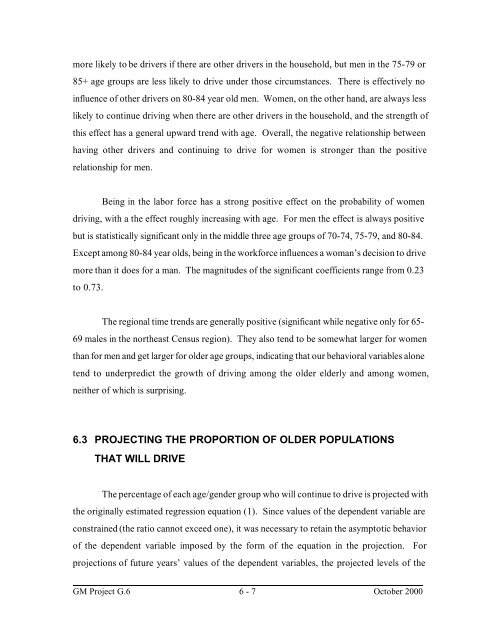Projecting Fatalities in Crashes Involving Older Drivers, 2000-2025
Projecting Fatalities in Crashes Involving Older Drivers, 2000-2025
Projecting Fatalities in Crashes Involving Older Drivers, 2000-2025
You also want an ePaper? Increase the reach of your titles
YUMPU automatically turns print PDFs into web optimized ePapers that Google loves.
more likely to be drivers if there are other drivers <strong>in</strong> the household, but men <strong>in</strong> the 75-79 or<br />
85+ age groups are less likely to drive under those circumstances. There is effectively no<br />
<strong>in</strong>fluence of other drivers on 80-84 year old men. Women, on the other hand, are always less<br />
likely to cont<strong>in</strong>ue driv<strong>in</strong>g when there are other drivers <strong>in</strong> the household, and the strength of<br />
this effect has a general upward trend with age. Overall, the negative relationship between<br />
hav<strong>in</strong>g other drivers and cont<strong>in</strong>u<strong>in</strong>g to drive for women is stronger than the positive<br />
relationship for men.<br />
Be<strong>in</strong>g <strong>in</strong> the labor force has a strong positive effect on the probability of women<br />
driv<strong>in</strong>g, with a the effect roughly <strong>in</strong>creas<strong>in</strong>g with age. For men the effect is always positive<br />
but is statistically significant only <strong>in</strong> the middle three age groups of 70-74, 75-79, and 80-84.<br />
Except among 80-84 year olds, be<strong>in</strong>g <strong>in</strong> the workforce <strong>in</strong>fluences a woman’s decision to drive<br />
more than it does for a man. The magnitudes of the significant coefficients range from 0.23<br />
to 0.73.<br />
The regional time trends are generally positive (significant while negative only for 65-<br />
69 males <strong>in</strong> the northeast Census region). They also tend to be somewhat larger for women<br />
than for men and get larger for older age groups, <strong>in</strong>dicat<strong>in</strong>g that our behavioral variables alone<br />
tend to underpredict the growth of driv<strong>in</strong>g among the older elderly and among women,<br />
neither of which is surpris<strong>in</strong>g.<br />
6.3 PROJECTING THE PROPORTION OF OLDER POPULATIONS<br />
THAT WILL DRIVE<br />
The percentage of each age/gender group who will cont<strong>in</strong>ue to drive is projected with<br />
the orig<strong>in</strong>ally estimated regression equation (1). S<strong>in</strong>ce values of the dependent variable are<br />
constra<strong>in</strong>ed (the ratio cannot exceed one), it was necessary to reta<strong>in</strong> the asymptotic behavior<br />
of the dependent variable imposed by the form of the equation <strong>in</strong> the projection. For<br />
projections of future years’ values of the dependent variables, the projected levels of the<br />
GM Project G.6 6 - 7<br />
October <strong>2000</strong>
















